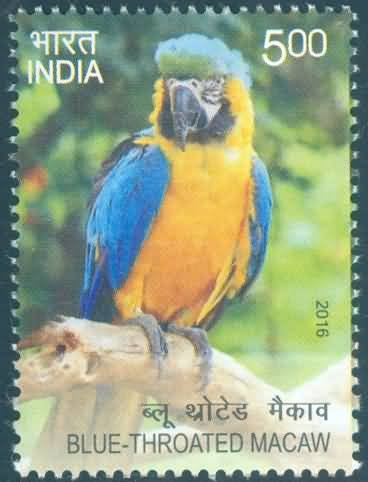Blue Throated Macaw

Technical Data
| Stamp Set | Exotic Birds |
|---|---|
| Date of Issue | December 5, 2016 |
| Denomination | Rs. 5 |
| Quantity | 200,000 |
| Perforation | 13¾ |
| Printer | Security Printing Press, Hyderabad |
| Printing Process | Wet Offset |
| Watermark | No Watermark |
| Colors | Multicolor |
| Credit (Designed By) | Smt. Alka Sharma |
| Catalog Codes |
Michel IN 3025A Yvert et Tellier IN 2732 Stanley Gibbons IN 3195 |
| Themes | Animals (Fauna) | Birds | Parrots |
The Rare Jewel of Bolivia
(Commemorative Postage Stamp)
The Blue-throated Macaw, also known as the Canindé Macaw, is one of the world’s rarest and most striking parrot species. Endemic to the tropical savanna forests of Central Bolivia, this magnificent bird stands as a symbol of both avian splendour and the urgent need for conservation. The Department of Posts honours this critically endangered species through a beautifully crafted commemorative postage stamp.
Distinctive Appearance
The Blue-throated Macaw is instantly recognisable by its vibrant colour palette and unique facial markings:
- Upperparts: A brilliant shade of turquoise blue, giving the bird a vivid tropical sheen.
- Underparts: Warm bright yellow, contrasting harmoniously with the cool blue tones.
- Throat & Cheeks: A defining blue throat along with blue feather-lines on the facial patch—delicate horizontal stripes unique to each individual bird, functioning almost like a natural signature.
- Bill: Large, curved, and glossy black, reflecting its powerful feeding habits.
This species can be distinguished from the somewhat larger Blue-and-Yellow Macaw by its deeper blue crown, its unmistakable blue throat, and its more uniform wing coloration.
Habitat & Distribution
- Found only in Central Bolivia, primarily in the lowland savanna forest and mixed woodland regions.
- Their habitat includes palm-rich islands of forest within open grasslands, where they feed, nest, and breed.
- This narrow geographic range makes the species especially vulnerable to environmental pressures.
Behaviour & Ecology
- Blue-throated Macaws are intelligent, social birds that often travel in pairs or small groups.
- Their diet typically includes palm fruits, seeds, nuts, and berries, particularly favouring the motacú palm.
- The species nests in cavities of tall trees, though limited nesting sites have contributed to population decline.
Conservation Status
The plight of the Blue-throated Macaw is one of the most urgent in avian conservation:
- Population: Recent surveys estimate only 350–400 individuals remaining in the wild.
- IUCN Red List: Classified as Critically Endangered.
- CITES: Listed under Appendix I, offering the highest level of protection against international trade.
Primary threats include habitat loss, competition for nesting sites, and historic trapping for the pet trade. Intensive conservation programmes are now working to increase population numbers through habitat protection, nest-box installations, and anti-poaching measures.
Cultural & Natural Significance
Revered for its beauty and rarity, the Blue-throated Macaw is a symbol of Bolivia’s rich biodiversity. Its striking plumage and soulful presence have made it an icon for conservationists and nature lovers around the world.
A Philatelic Tribute
By issuing this commemorative postage stamp, the Department of Posts celebrates the enchanting Blue-throated Macaw and highlights its fragile existence. This philatelic release serves as a reminder of our shared responsibility to protect the world’s most vulnerable species and preserve the natural heritage they represent.
